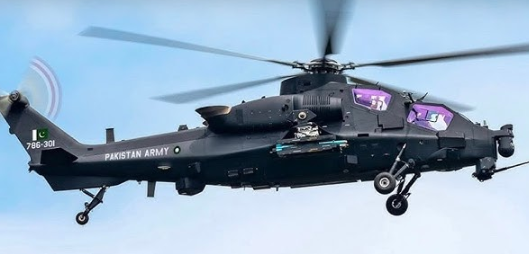In a significant step to enhance its operational strength, the Pakistan Army has officially inducted the Chinese-made Z-10ME attack helicopters, aiming to strengthen its battlefield response capabilities. The induction ceremony, overseen by Chief of Army Staff (COAS) Field Marshal Asim Munir, took place recently at the Muzaffargarh Field Firing Ranges, where the helicopters demonstrated their firepower in front of military leadership.
The Z-10ME, showcased internationally for the first time at the Singapore Airshow earlier this year by China’s Aviation Industry Corporation, is touted as a highly advanced all-weather attack platform. While Pakistan was noted as the only confirmed customer abroad at that event, the recent formal induction confirms the army’s commitment to modernizing its aviation assets. Although the exact number of helicopters acquired remains undisclosed, the ISPR described the move as a major leap in army aviation modernization.
According to the military’s media wing, the Z-10ME is equipped with sophisticated radar and electronic warfare systems, enabling precision strikes both day and night. This upgrade is expected to significantly boost Pakistan’s ability to counter diverse aerial and ground threats, contributing to a more integrated and responsive battlefield strategy.
Interestingly, Pakistan’s earlier experience with the Z-10 was less smooth; Defense News reported that in 2021, China had sent three Z-10 helicopters for testing in Pakistan, but these failed to meet the army’s expectations and were returned. Despite that, experts like former Australian defence attaché Brian Cloughley had suggested Pakistan would continue to evaluate newer variants, which appears to have led to the current acquisition of the enhanced Z-10ME model.
During the demonstration, COAS Munir praised the troops for their morale, professionalism, and operational readiness, noting the successful display of combined arms tactics. His remarks emphasized the army’s determination to maintain a technological and tactical edge amid evolving warfare challenges.
Beyond military hardware, Field Marshal Munir used his visit to engage with academia and civil society leaders, highlighting the critical role of national unity and collaboration between civil and military sectors. He stressed that a comprehensive “whole-of-nation” approach is essential to counter hybrid threats—complex challenges that blend conventional and unconventional tactics.
At the Multan Garrison, where the COAS also reviewed training and operational preparedness, he reaffirmed the army’s steadfast commitment to defending Pakistan’s sovereignty and territorial integrity, expressing satisfaction with the high standards maintained by the forces.
This move signals a clear intent by Pakistan to bolster its defense technology and adapt to modern battlefield demands, while reinforcing the importance of cohesive national effort in security matters.
